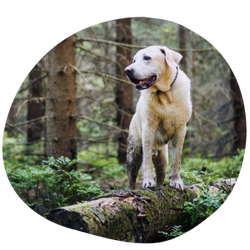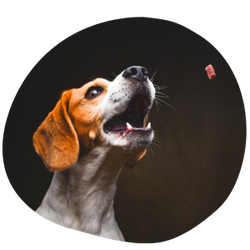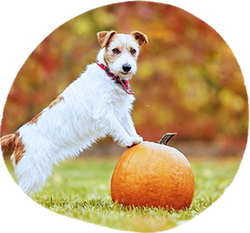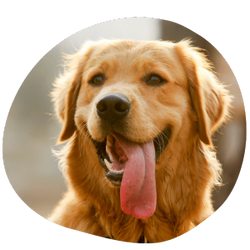No Products in the Cart
GREAT DANE FACTS: EVERYTHING YOU NEED TO KNOW ABOUT
Posted By Jérémy ADJOVI-BOCO, 12 August 2023
Great Dane: Physical Characteristics & Health
Hi Jope's squad !
The great Dane is one of the sweetest-tempered dog breeds ever! Don't be fooled by their giant size. This breed is smart, great with families, and can make the perfect first dog. In this article, we’ll walk you through everything there is to know about this breed—from the history to health concerns.
Because of their giant size, great Danes tend to make you feel intimidated or make you fall in love. Here at Jope, we’re in the second category. Christine has a soft spot for great Danes—though they’re almost as tall as she is!

Where did Great Danes come from?
Did you know great Danes aren’t actually from Denmark? Originally from Germany, the great Dane was initially a mixed breed. Great Dane breeders crossed the Bullenbeisser (the German bulldog, a now-extinct breed) with large hounds that used to hunt wild boar. Breeders selected these hounds for their power, flexibility, and speed.
So, how did great Danes get their name? In the late 1800s, German breeders exported this new mixed breed to Denmark. There, Danes fell in love with these majestic dogs. That’s where the name “great Dane” comes from.
Initially, though, the term “great Dane” referred to large, powerful dogs that weren’t considered a real breed, strictly speaking. Then, in 1878, breeders and judges started referring to great Danes as a breed. Finally, in 1880, experts agreed on the first official breed standards for great Danes. As you can imagine, it took several years for these dogs to become the great Danes we know and love today.
Do great Danes need a lot of exercise?
Although great Danes love to play sometimes, they’re generally not the most active dogs. However, this lovable breed is very gentle and attentive.
Another adorable fact about these loving giants is that they can be very needy. Luckily, though, great Danes are easy to please. A simple look in their direction, a kind word, or a pat on their head will satisfy their need for attention.
And these good dogs are known to reward affection by wagging their tails with joy. If only we could all be so easily pleased!
Although great Danes are like big teddy bears, puppies of this breed need to be trained early! These big, muscular dogs require exercise to stay healthy. And if you don't want your 140-pound friend to walk you, you have to start training your great Dane as soon as you get them. Thankfully, firm, breed-appropriate training will do the trick. Because of their sweet and docile temperament, great Danes are fairly easy to train.
Great Danes are laid-back and calm. They love to lounge on the couch, making them excellent companions to watch Netflix with. When resting, they often sit still or pose majestically while guarding their owners.
Think of them as canine guardian angels!

Photography of a beautiful Great Danes
Are Great Danes the largest dog breed ?
Yes Great Danes are the largest dog breed.
Great Danes are big and powerful. Some people even refer to them as the Greek god Apollo! And they’re right.
Male great Danes can easily measure 31 inches long and weigh 150 pounds. Meanwhile, female great Danes can measure over 27 inches long and weigh 110 pounds.
This breed is known for handsomely proportioned heads. They also have very well-defined lines and expressive, loving eyes. Long, muscular necks are another classic great Dane feature.


Best Collagen for Dogs - Vet's Expert Advice
Collagen, a rising star in pet wellness, offers diverse forms designed for specific benefits. When it comes to boosting your dog's joint health, find out which collagen solution is the right fit for them...
Learn More
These dogs’ ears are nicely proportioned to their heads, falling elegantly onto their cheeks.
Also Read: Inulin For Dogs
You might have heard about the ear cropping of your great Dane and wonder whether it’s a good idea. Historically, great Danes had their ears cropped because they were used to hunt wild boars. Ear cropping minimized their risk of getting hurt by the boars or other wild animals during hunts. Nowadays, since great Danes aren’t hunting wild boars, cropping has become purely an aesthetic choice. Because there are no proven health benefits of ear cropping for your dog, we feel that ear cropping should not be recommended.
Great Danes—especially males—have broad shoulders and strong bodies. They stand with a very sturdy stance. Their strong tails are set high, and they gracefully fall beside their calves.

Traditionally, great Danes come in three different colors: fawn and brindle, black and harlequin, and blue. Nowadays, other great Dane colors are popular, too. Whatever their coloring, great Danes’ coats are shiny and smooth. Their fur grows short and thick.
Looking for more facts on great Danes’ breed standards and physical characteristics?
Check out the great Dane file at the FCI (International Cynological Federation).
Do great Danes shed a lot?
Great Danes are well loved for their velvety fur, but people often wonder if they shed a lot. The breed is not hypoallergenic, and great Danes do shed moderately. However, since great Danes aren’t the first dogs to run around and play in the mud, they don’t need much maintenance or grooming. Giving them a bath twice a year should be enough to keep them clean—and to keep your couch spotless.
On the other hand, great Dane owners do need to trim their dogs’ nails. Great Danes’ claws should be cut back regularly because this breed doesn’t run around much, unlike smaller dog breeds. So, a good manicure once a month is highly recommended.
You might also wonder if great Danes are prone to skin problems. Some great Danes have a little excess skin around their eyes. For these dogs, we recommend gently cleaning the eyes with a saline solution to avoid eye problems.
What health problems are great Danes prone to as a breed?
The risk of bloat for puppies and adult great Danes
Like all giant-breed dogs, great Danes can be predisposed to certain medical conditions. First, they’re especially prone to gastric dilatation-volvulus (GDV)—a complication of bloat. This life-threatening emergency is extremely painful. When GDV occurs, the stomach is overstretched, and it rotates in on itself due to too much trapped gas. As a result, the blood flow to the dog’s stomach is blocked. This blockage causes necrosis of the stomach and a build-up of toxins in the bloodstream.
Preventative treatments and surgery are available to avoid bloat. If you’re worried about your great Dane getting bloat, talk to your vet.
Veterinarians can perform preventive surgery at the same time as another routine procedure, like a spay or neuter. This preventative surgery is called gastropexy or more commonly "tacking". The dog’s stomach is stitched to their abdominal wall or diaphragm, keeping it from stretching and rotating due to bloat.
If you want to know more about GDV or dog bloat, check our dedicated article on the link above.
Other health issues and joint inflammation
Because great Danes are a very fast-growing breed, they can develop joint problems after intense physical activity as puppies. So, we recommend keeping great Dane puppies’ activity moderate until they have fully grown between 18 to 24 months old. And to protect their joints with supplements as soon as 12 months of age.
Also, great Danes are prone to both elbow dysplasia and hip dysplasia. If your great Dane shows any signs or symptoms of these bone and joint problems, talk to your vet.
In addition to your veterinarian’s treatment, you can include joint-health products like Jope’s Hip and Joint health chew when feeding your great Dane.


Like other large-breed dogs, great Danes are also especially prone to bone tumors. These bone tumors are called osteosarcomas.
Unfortunately, this breed is also at a high risk of heart disease, including a condition called dilated cardiomyopathy.
Finally, these dogs can also develop skin problems, like demodicosis and skin-fold abnormalities.
Do not feel overwhelmed when reading about this breed's possible predispositions, as this doesn't mean your Great Dane will present with any. However, because all breeds have predispositions, you should be aware of them as a pet parent to watch for signs and work with your veterinarian if you notice a change in your dog.
Keeping your great Dane healthy
As you can see, great Danes are a sensitive breed overall, requiring special care. For that reason, we strongly recommend feeding your great Dane high-quality dog food, keeping them up to date on their vaccines and parasite prevention, and spaying or neutering if you’re not breeding your dog. Surgery to prevent bloat is also worth considering for healthy, young great Danes.
By taking good care of your great Dane, you can help these gentle giants live happy, healthy lives. The breed’s average lifespan is 10 to 14 years.
Finally, note that the costs for vet appointments and surgeries are always high for diseases or accidents. However, pet care costs can be even higher for giant-breed dogs! So, a pet insurance plan can be worthwhile for great Dane owners.
Also read about other breeds: German Shepherds, Labradors, Chow Chows, Corgi, French Bull Dog















Leave a comment